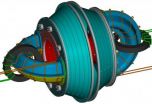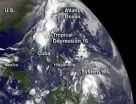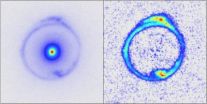(Press-News.org) Researchers around the world are working on an efficient, reliable way to contain the plasma used in fusion reactors, potentially bringing down the cost of this promising but technically elusive energy source. A new finding from the University of Washington could help contain and stabilize the plasma using as little as 1 percent of the energy required by current methods.
"All of a sudden the current energy goes from being almost too much to almost negligible," said lead author Thomas Jarboe, a UW professor of aeronautics and astronautics. He presents the findings this week at the International Atomic Energy Association's 24th annual Fusion Energy Conference in San Diego.
The new equipment looks like handles on a coffee mug – except they attach to a vessel containing a million-degree plasma that is literally too hot to handle.
Most people know about nuclear fission, the commercial type of nuclear power generated from splitting large atoms in two. Still under research is nuclear fusion, which smashes two small atoms together, releasing energy without requiring rare elements or generating radioactive waste.
Of course, there's a catch – smashing the atoms together takes a lot of energy, and scientists are still working on a way to do it so you get out more energy than you put in. The sun is a powerful fusion reactor but we can't recreate a full-scale sun on Earth.
An international project in France is building a multibillion-dollar fusion reactor to see whether a big enough reactor can generate fusion power.
The reactor in France will inject high-frequency electromagnetic waves and high-speed hydrogen ions to sustain the plasma by maintaining an even hotter 100-million-degree operating temperature and enclosing it with magnetic fields.
"That method works," Jarboe said, "but it's extremely inefficient and expensive, to the point that it really is a major problem with magnetic confinement."
For two decades Jarboe's team has worked on helicity injection as a more efficient alternative. Spirals in the plasma produce asymmetric currents that generate the right electric and magnetic fields to heat and confine the contents. Plasma is so hot that the electrons have separated from the nuclei. It cannot touch any walls and so instead is contained by a magnetic bottle. Keeping the plasma hot enough and sustaining those magnetic fields requires a lot of energy.
"We would drive it until it was unstable," Jarboe said of his approach. "Like you twist up a rope, the plasma twists up on itself and makes the instability and makes the current drive."
Results showed the UW strategy required less energy than other methods, but the system was unstable, meaning that if conditions change it could wobble out of control. It's like a stick balancing on one end, which is stable at that moment, but is likely to come crashing down with any nudge. In the case of plasma, unstable equilibrium means that a twist in the plasma could cause it to escape and potentially lead to a costly reactor shutdown.
Instability was a major impediment to applying the UW method.
"The big issue is whether, when you distort the bottle, it will leak," Jarboe said.
By contrast, in a stable equilibrium, any shift will tend to come back toward the original state, like a ball resting at the bottom of a bowl that will settle back where it started.
"Here we imposed the asymmetric field, so the plasma doesn't have to go unstable in order for us to drive the current. We've shown that we can sustain a stable equilibrium and we can control the plasma, which means the bottle will be able to hold more plasma," Jarboe said.
The UW apparatus uses two handle-shaped coils to alternately generate currents on either side of the central core, a method the authors call imposed dynamo current drive. Results show the plasma is stable and the method is energy-efficient, but the UW research reactor is too small to fully contain the plasma without some escaping as a gas. Next, the team hopes to attach the device to a larger reactor to see if it can maintain a sufficiently tight magnetic bottle.
INFORMATION:
The research is funded by the U.S. Department of Energy. Co-authors are Brian Nelson, research associate professor of electrical engineering; and research associate Brian Victor, research scientists David Ennis, Nathaniel Hicks, George Marklin and Roger Smith and graduate students Chris Hansen, Aaron Hossack, Cihan Ackay and Kyle Morgan, all in UW aeronautics and astronautics.
For more information, contact Jarboe at 206-685-3427 or jarboe@aa.washington.edu.
His presentation will take place Saturday, Oct. 13, at 11:05 a.m. in the Indigo Ballroom of the Hilton San Diego Bayfront Hotel, in the Innovative Confinement Concepts track.
Mug handles could help hot plasma give lower-cost, controllable fusion energy
2012-10-12
ELSE PRESS RELEASES FROM THIS DATE:
More than just 'zoning out' -- Exploring the cognitive processes behind mind wandering
2012-10-12
It happens innocently enough: One minute you're sitting at your desk, working on a report, and the next minute you're thinking about how you probably need to do laundry and that you want to try the new restaurant down the street. Mind wandering is a frequent and common occurrence. And while mind wandering in certain situations – in class, for example – can be counterproductive, some research suggests that mind wandering isn't necessarily a bad thing.
New research published in the journals of the Association for Psychological Science explores mind wandering in various ...
Duke Medicine news -- Anti-cancer drug fights immune reaction in some infants with Pompe disease
2012-10-12
DURHAM, N.C. – Adding a third anti-cancer agent to a current drug cocktail appears to have contributed to dramatic improvement in three infants with the most severe form of Pompe disease -- a rare, often-fatal genetic disorder characterized by low or no production of an enzyme crucial to survival.
Duke researchers previously pioneered the development of the first effective treatment for Pompe disease via enzyme replacement therapy (ERT). ERT relies on a manufactured enzyme/protein to act as a substitute for the enzyme known to be lacking in patients with a particular disease. ...
New studies reveal connections between animals' microbial communities and behavior
2012-10-12
Athens, Ga. – New research is revealing surprising connections between animal microbiomes—the communities of microbes that live inside animals' bodies—and animal behavior, according to a paper by University of Georgia ecologist Vanessa O. Ezenwa and her colleagues. The article, just published in the Perspectives section of the journal Science, reviews recent developments in this emerging research area and offers questions for future investigation.
The paper grew out of a National Science Foundation-sponsored workshop on new ways to approach the study of animal behavior. ...
Enzyme triggers cell death in heart attack
2012-10-12
University of Iowa researchers have previously shown that an enzyme called CaM kinase II plays a pivotal role in the death of heart cells following a heart attack or other conditions that damage or stress heart muscle. Loss of beating heart cells is generally permanent and leads to heart failure, a serious, debilitating condition that affects 5.8 million people in the United States.
Now the UI team, led by Mark Anderson, M.D., Ph.D., professor and head of internal medicine at the UI Carver College of Medicine, has honed in on how CaM kinase II triggers heart cell death ...
New treatments for epilepsy, behavioral disorders could result from Wayne State studies
2012-10-12
Three studies conducted as part of Wayne State University's Systems Biology of Epilepsy Project (SBEP) could result in new types of treatment for the disease and, as a bonus, for behavioral disorders as well.
The SBEP started out with funds from the President's Research Enhancement Fund and spanned neurology, neuroscience, genetics and computational biology. It since has been supported by multiple National Institutes of Health-funded grants aimed at identifying the underlying causes of epilepsy, and it is uniquely integrated within the Comprehensive Epilepsy Program at ...
Safety results of intra-arterial stem cell clinical trial for stroke presented
2012-10-12
HOUSTON – (Oct. 11, 2012) – Early results of a Phase II intra-arterial stem cell trial for ischemic stroke showed no adverse events associated with the first 10 patients, allowing investigators to expand the study to a targeted total of 100 patients.
The results were presented today by Sean Savitz, M.D., professor of neurology and director of the Stroke Program at The University of Texas Health Science Center at Houston (UTHealth), at the 8th World Stroke Congress in Brasilia, Brazil.
The trial is the only randomized, double-blind, placebo-controlled intra-arterial clinical ...
Satellite sees 16th Atlantic tropical depression born near Bahamas
2012-10-12
The 16th tropical depression of the Atlantic Ocean season has formed northeast of the Bahamas and NOAA's GOES-14 satellite captured a visible image of the storm as it tracks to the southwest.
NOAA's GOES-14 satellite captured a visible image of newborn Tropical Depression 16 (TD16) near the Bahamas on Oct. 11 at 7:45 a.m. EDT. TD16 appeared as a rounded area of clouds just northeast of the Bahamas and its western fringes were just off the Florida east coast. GOES-14 also showed another low pressure area with the potential for development a few hundred miles from the Windward ...
NASA sees Typhoon Prapiroon doing a 'Sit and Spin' in the Philippine Sea
2012-10-12
As Typhoon Prapiroon slowed down and became quasi-stationary in the Philippine Sea NASA's Terra satellite passed overhead and captured an image of the storm.
NASA's Terra satellite passed over Typhoon Prapiroon on Oct. 11 at 0210 UTC (1010 p.m. EDT, Oct. 10) and the Moderate Resolution Imaging Spectroradiometer (MODIS) instrument captured a visible image of the storm. The visible imagery clearly showed a small ragged eye, and microwave satellite imagery confirmed the eye. Satellite imagery also confirmed a well-defined low-level center of circulation.
By 11 a.m. EDT ...
Nurture trumps nature in study of oral bacteria in human twins, says CU study
2012-10-12
A new long-term study of human twins by University of Colorado Boulder researchers indicates the makeup of the population of bacteria bathing in their saliva is driven more by environmental factors than heritability.
The study compares saliva samples from identical and fraternal twins to see how much "bacterial communities" in saliva vary from mouth to mouth at different points in time, said study leader and CU-Boulder Professor Kenneth Krauter. The twin studies show that the environment, rather than a person's genetic background, is more important in determining the ...
When galaxies eat galaxies
2012-10-12
SALT LAKE CITY, Oct. 11, 2012 – Using gravitational "lenses" in space, University of Utah astronomers discovered that the centers of the biggest galaxies are growing denser – evidence of repeated collisions and mergers by massive galaxies with 100 billion stars.
"We found that during the last 6 billion years, the matter that makes up massive elliptical galaxies is getting more concentrated toward the centers of those galaxies. This is evidence that big galaxies are crashing into other big galaxies to make even bigger galaxies," says astronomer Adam Bolton, principal ...



